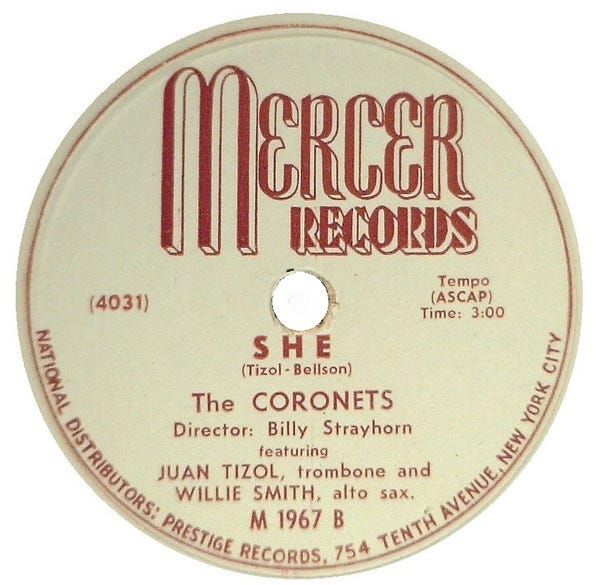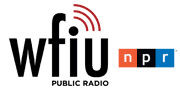
Night Lights takes a dive into an obscure treasure trove of Ellingtonia, recorded for Ellington's own record label in the early 1950s.
Across the arc of his spectacular 20th-century career Duke Ellington was a pianist, a bandleader, a composer and arranger…and, at one time, Duke Ellington was a record-label owner. At the beginning of the 1950s his Mercer Records imprint released a fascinating array of recordings that have remained relatively obscure, and that marked Ellington’s formal return to the small-group format after a decade-long pause. On this episode of Night Lights we’ll hear piano duets by Ellington and writing partner Billy Strayhorn, Strayhorn-led dates featuring saxophonist Johnny Hodges and other Ellingtonians, and notable sides recorded by saxophonist Coleman Hawkins, singer Al Hibbler, and bassist Oscar Pettiford.
Duke Ellington and Billy Strayhorn barreling away on two pianos with “Great Times,” recorded for Ellington’s Mercer label in 1950. Strayhorn before that leading an Ellingtonian small group on another Mercer label date, doing “Britt and Butter Blues.”
The Blooming of "Lotus Blossom"
After Duke Ellington’s beloved longtime writing partner Billy Strayhorn passed away from cancer at the age of 51 in 1967, a bereaved Ellington took his band into the studio to make an album that would become a tribute to his departed collaborator, …And His Mother Called Him Bill. His impromptu solo-piano performance of Strayhorn’s hauntingly beautiful ballad “Lotus Blossom,” while Ellington band members can be heard at first chatting and packing up in the background, then subsiding into silence as their leader bears his grief through the compositional pathway left behind by Strayhorn, has become a powerful and iconic moment in the Ellington discography that also elevated the stature of Strayhorn’s piece.
I had long thought that that 1967 album marked “Lotus Blossom’s” first appearance on record.* (see note from Ellington scholar Steven Lasker at the bottom of this post.) But Ellington saxophonist Johnny Hodges had recorded the tune 20 years prior, for an obscure, short-lived record label owned by Ellington himself called Sunrise, and which eventually morphed into the Ellington-underwritten label Mercer Records, named after his son Mercer, who along with jazz critic Leonard Feather managed and promoted the label.
Mercer Records is a fascinating chapter in Ellington’s career, yet another example of a 20th-century Black jazz artist pursuing what decades later would come to be down as the “DIY” or Do It Yourself movement, in which musicians founded their own record labels to give them more commercial and creative control of their music. On this edition of Night Lights I’ll be exploring the output and story of Ellington’s venture into this realm, which yielded a treasure trove of musical riches featuring pianist and writing partner Billy Strayhorn, as well as other musicians in the Ellington orbit. In the meantime, let’s hear that original, little-known 1947 debut of “Lotus Blossom,” then called “Charlotte Russe,” on Night Lights:
Saxophonist Johnny Hodges and the first-ever recording of Billy Strayhorn’s composition “Lotus Blossom,” originally titled “Charlotte Russe,” made for Duke Ellington’s short-lived 1947 Sunrise record label and subsequently included on a 1950 Mercer Records 10-inch LP.
The Sunrise label was not the only precedent for Ellington’s interest in developing more business control over his music. In 1940 Ellington founded his own music-publishing company, Tempo Music. Harvey G. Cohen writes in his book Duke Ellington’s America that “the creation of Tempo was a business move that greatly aided the survival of Ellington’s band and his music during the decades that followed… Ellington gained more autonomy and set an important precedent for African Americans and all jazz artists controlling their own publishing.” And Ellington’s brief association with the Musicraft label in the mid-1940s had given him a share of ownership in the company. But it was Mercer Records, named after Ellington’s son Mercer, that marked Ellington’s most significant venture into what is now called “DIY,” artists attempting to empower themselves and their work through increased ownership of the means of musical production and distribution.
Among the highlights of the small but notable Mercer discography are recordings made by Billy Strayhorn-led small groups, an array of duets featuring Strayhorn and Ellington on two pianos, the last glimpses of singer Al Hibbler in an Ellingtonian setting, and some sides from bassist and cellist Oscar Pettiford, who had held the bass chair in the Ellington orchestra for several years during the mid-1940s. While playing with the Woody Herman big band in 1949 Pettiford had broken his arm, and a lengthy rehabilitation process temporarily prevented him from continuing on the instrument. Instead he took up cello, and in 1950 made his debut with it on Ellington’s Mercer label, producing what are among the earliest jazz cello recordings, with Ellington himself on piano. We’ll hear two of them now, beginning with a track that adds Billy Strayhorn to the mix on celeste—Oscar Pettiford and “Oscarlypso,” on Night Lights:
Oscar Pettiford performing Juan Tizol’s “Perdido,” with Pettiford on cello, Duke Ellington on piano, Lloyd Trotman on bass, and Jo Jones on drums, recorded for Ellington’s Mercer label in September of 1950. Pettiford before that doing his composition “Oscalypso” with the same group, but with Billy Strayhorn added on celeste, also recorded for Mercer Records in Sept 1950.
One of the most interesting Mercer recordings is an Ellington-led small-group date that includes two young artists from the late-1940s bebop movement—drummer Max Roach and trumpeter Red Rodney. The tune “New Piano Roll Blues” was played by Ellington on what’s called prepared-piano, when small objects are placed on the strings or hammers of the piano to alter the instrument’s sound. Some listeners find that the resulting recording presciently evokes the legendary Money Jungle album that Ellington would record with Roach and bassist Charles Mingus more than ten years later, and writer and musician Allen Lowe cites it in his jazz history That Devilin’ Tune as Ellington’s appreciative nod to the bebop school, praising the pianist’s adaptation to Roach’s “playing (that) was like a metallic maze of straight cymbal time and broken-field accents… together they showed how irrelevant specific ‘schools’ of jazz playing could be, meeting not on some stylistically nebulous middle ground but on the common ground of inspired improvisation.” In this set we’ll also hear the first of several Duke Ellington-Billy Strayhorn duets that were recorded for the Mercer label—a blazing revisitation of Ellington’s 1940 “Cottontail” showcase for saxophonist Ben Webster. First, Duke Ellington, Max Roach, and “The New Piano Roll Blues,” on Night Lights:
Duke Ellington and Billy Strayhorn on two pianos doing Ellington’s “Cottontail” for Mercer Records in 1950, joined by bassist Wendell Marshall. Ellington before that on prepared piano performing the modernistic “The New Piano Roll Blues,” joined by some Ellingtonians plus young beboppers drummer Max Roach and trumpeter Red Rodney, recorded for Mercer in 1950.
Something else notable about Ellington’s Mercer Records era—it marked the resumption after a decade-long pause of Ellington and others in the band making small-group dates under the Ellingtonian umbrella in addition to full-orchestra recordings. When Ellington’s then-manager Irving Mills established the Master and Variety labels in 1936s, it sparked a run of recordings by Ellington-related small groups that lasted into the beginning of the 1940s, with dates often led by Johnny Hodges, Cootie Williams, and other Ellington orchestra members, often with Duke himself on piano. That activity largely ceased throughout the 1940s (though there are excellent scattered dates by Ellingtonians across the Keynote, H.R.S, and Capitol labels during these years, in addition to the records that Hodges cut for Mercer's predecessor Sunrise), but when Ellington started Mercer Records, he was already under contract to Columbia and forbidden, according to one commentator, from recording under the moniker of the Ellington big band on any other label. Whatever the details of the Columbia deal, the records made for Mercer returned the Ellingtonians more frequently to a small-group setting, often billed as the Coronets, or Billy Strayhorn’s All-Stars. We’ll hear one example now, featuring trumpeter Cat Anderson, with “Night Walk,” on Night Lights:
The Coronets, led by pianist Billy Strayhorn, performing Cat Anderson’s “Night Walk,” featuring Anderson on trumpet, recorded for Duke Ellington’s Mercer label in 1951.
Mercer’s output included musicians outside of the Ellington orbit as well, but nearly all of the sessions were led or rostered by Ellington-associated artists. At the heart of the label's discography are eight piano duets featuring Duke Ellington and Billy Strayhorn, accompanied only by a bassist. Although Ellington and Strayhorn reportedly had a penchant for sometimes performing two-piano duets, or a duet on a single piano, in late-night social and private settings, the two in this format had only been recorded once, for Strayhorn’s composition “Tonk” at a 1946 Victor session. For Mercer they made what proved to be an album’s worth, melding together so seamlessly that Strayhorn himself later confessed, “I really have to sit down at a keyboard and play it out for myself to know for sure who is playing.” Duke Ellington, Billy Strayhorn, and “Tonk,” on Night Lights:
The dynamic duo of Duke Ellington and Billy Strayhorn in double-piano action, performing Strayhorn’s composition “Johnny Come Lately,” and “Tonk” before that, both recorded for Duke Ellington’s Mercer record label in November of 1950.
Our next set of Mercer Records selections features “She,” a tune written by drummer Louis Bellson and trombonist Juan Tizol, who joined the Ellington orchestra in 1951 along with saxophonist Willie Smith. All three had been members of Harry James’ popular orchestra, and Ellington’s luring away of them came to be known as “the Great James Robbery.” Ellington made his move after longstanding Ellingtonians Johnny Hodges, Lawrence Brown and Sonny Greer all parted ways with their leader. Once again we’ll hear Ellington musicians directed by Billy Strayhorn in the small-group format, a musical context that Ellington had largely abandoned after a strong run of such recordings between 1936 and 1941. We’ll also hear an extended solo on a piece titled “The Happening” by the band’s then-new tenor saxophonist Paul Gonsalves, who in just a few years would make jazz history with his 27-chorous tour de force at the 1956 Newport Jazz Festival. First, the Coronets and “She,” on Night Lights:
“The Happening,” written by and featuring then-new-to-the-ranks tenor saxophonist Paul Gonsalves, recorded by the Coronets led by pianist Billy Strayhorn in April 1951 for Duke Ellington’s Mercer label. Before that, from the same date we heard the Coronets performing newly-minted Ellingtonians drummer Louis Bellson and trombonist Juan Tizol’s “She.”
Singer Al Hibbler was an Ellington veteran when he made his recordings for Ellington’s Mercer label in 1950 and 1951. Hibbler, a baritone who’d been blind since birth, had joined the orchestra in 1943 and would leave around the time of his final sessions for Mercer. Hibbler’s stately, soulful delivery worked especially well in slow and medium-tempo contexts for the Ellington orchestra, and he occupies pride of place as a male singer in the Ellington discography. After his departure from the band’s orbit he scored some hits with Decca and became a civil-rights activist. One of his last albums was a 1972 pairing with fellow blind artist and multi-instrumentalist Rahsaan Roland Kirk.
We’ll hear two of the recordings that Hibbler made for Mercer, showcasing him on songs that are now considered American songbook classics. At least I think I can say that with confidence about this one—Al Hibbler in 1950 with a Billy Strayhorn-led group that included non-Ellington jazz notables Benny Carter on alto sax and Dave Barbour on guitar, doing “Stardust,” on Night Lights:
Al Hibbler performing “Summertime,” recorded for Duke Ellington’s Mercer record label in the summer of 1951, backed by a small group of Ellingtonians including pianist Billy Strayhorn… and Hibbler before that in 1950 doing “Stardust” for the Mercer label as well, accompanied by another Strayhorn-directed combo including alto saxophonist Benny Carter, baritone saxophonist Harry Carney, and guitarist Dave Barbour.
Mercer Records ultimately had a short run, with Mercer Ellington suspending recording activities by 1952, writing decades later in the Ellington memoir Music Is My Mistress that he was acting at the behest of his father after the operation finally broke even. Mercer partner and jazz writer Leonard Feather later cited the label’s rocky timing as the record market began to shift from 78s to LPs for its failure to take off. Mercer never enjoyed any hits, outside of an Al Hibbler waxing of “White Christmas” and one of the Ellington-Oscar Pettiford sides that have been noted as having made any kind of impact in the marketplace.
In 1957 Billboard reported the sale of Mercer's catalogue to Coral Records. Although the label’s masters had been destroyed in a fire, much of the Ellington-related material was eventually reissued in the CD era, scattered across several individual releases. In his book Duke Ellington’s America Harvey G. Cohen notes Mercer’s low sales and writes that “The effort failed financially, but artistically and in terms of promotion, and perhaps even as a tax write-off, the label met with some success. The story of Mercer Records provides another example of how Ellington and his associates developed creative and aggressive ways to keep his name before the public, refusing to be relegated to the periphery of the rapidly shifting music business that claimed so many of his peers.” The story of Mercer Records also includes some of the most interesting small-group recordings in the Ellington discography.
We’ll hear a real Mercer Records obscurity in this last set—a 1949 recording that saxophonist Coleman Hawkins made of Duke Ellington’s standard “Sophisticated Lady" in Paris. First, the Coronets performing a tune described by Ellington scholar Eddie Lambert as “Strayhorn exotica”--“Swamp Drum,” on Night Lights:
Special thanks to Steven Lasker, Joe Medjuck, Nick Rossi,the late Phil Schaap,the Duke Ellington Society Facebook group, and members of the Organissimo jazz forum.
SOURCES FOR THE SHOW
Books:
Duke Ellington, Music Is My Mistress
Harvey G. Cohen, Duke Ellington's America (Night Lights review: He, Too, Was America: Duke Ellington's Sepia Panorama)
Eddie Lambert, Duke Ellington: A Listener's Guide
Recordings:
Duke Ellington, On Mercer: Great Times (a new single-CD collection of the Mercer catalogue)
Duke Ellington/Billy Strayhorn, Piano Duets: Great Times
Johnny Hodges/Duke Ellington All Stars/Billy Strayhorn All Stars, Caravan
Al Hibbler, 1950-1952
DEEP DIVE
Listen to the late Phil Schaap's 2018 Ellington birthday tribute broadcast, which delves into Ellington's attempts to gain more control of his music throughout his career, including the establishing of Mercer Records in 1950.
PROGRAM OUTTAKES
"LOTUS BLOSSOM" ON RECORD
Steven Lasker, one of the world's foremost Ellington scholars, and several others pointed me to several discographical appearances of "Lotus Blossom" between Hodges' 1947 Mercer version (then called "Charlotte Russe," and initally copyrighted by Strayhorn as "Hominy," according to Strayhorn scholar Walter van de Leur) and Ellington's 1967 revisitation for ...And His Mother Called Him Bill, though none of them were released at the time. In response to my query about the origins of "Lotus Blossom," Lasker writes:
Charlotte Russe was recorded in Detroit in late October 1947. The piece was in 4/4. I believe this was the only recording of the piece under this title. It was issued in France on Jazz Selection JS 645 (78 rpm) with composer's credit to "B. Strayhorn." The first American issue, released in 1950 or 1951 on Mercer LP 1000 ("mercer records proudly presents johnny hodges and his orchestra"), was credited to "Ellington-Hodges".
The earliest recording of the title Lotus Blossom was made in NY for Verve on April 7, 1959, and was first released in 1979 on Verve VE-2-2532 (Johnny Hodges, "A Smooth One"). The piece is again in 4/4. But despite the composer's credit to Strayhorn, the melody doesn't resemble Charlotte Russe to my ears:
Charlotte Russe (1947): https://www.youtube.com/watch?v=WIhx_XxXmKE
Lotus Blossom (1959): https://www.youtube.com/watch?v=yhKdMH0Mlxk
Note that while Charlotte Russe is in 4/4 in its original recording, Ellington played it in 3/4 as Lotus Blossom. One supposes that Ellington was behind the change in time signature, but this isn't mentioned either in Stanley Dance's notes to "A Smooth One," or in John Clement's notes to the Mosaic set "The Complete Verve Johnny Hodges Small Group Sessions 1956-61.
Ellington first recorded Lotus Blossom at Radio Recorders in Hollywood on March 2, 1961. It was for Columbia, but no mx. # was assigned. It was first issued in 1984 on CBS 88654, a 2-Lp set. Ellington is joined by Aaron Bell and Sam Woodyard. Here's the track, composer's credit to Billy Strayhorn:
https://www.youtube.com/watch?v=lpkac71mO5E (It's in print as a bonus track on the CD of Piano in the Foreground.)
The same trio recorded the piece at a concert held Jan. 4, 1962 at the Museum of Modern Art. It has been issued in France:
https://www.maison-du-duke.com/c7j8vr2v58/fichiers/CD_Fiche_MDD001.pdf
The first solo version of Lotus Blossom was recorded by Duke in Copenhagen on Jan. 23, 1967:
https://www.youtube.com/watch?v=KKVOytNRAx4
Musician and Ellington scholar Nick Rossi concurs with Lasker about the 1959 recording by Hodges titled "Lotus Blossom" not being the same composition:
I very much agree that the title recorded by Hodges in April 1959 and first issued in 1979 by Verve as Lotus Blossom is very much dissimilar to the titles you mention below. In fact, I will go a step further and say that it is a different tune entirely. The online version of the Lord Jazz Discography appears to have corrected this and currently lists it as Untitled Original.
Lotus Blossom by Hodges [1947]: https://youtu.be/6OS2KxdKPXw?si=lgT7lNjGr2g4qnf3
Untitled Original (issued in 1979 as Lotus Blossom) by Hodges [1959]: https://youtu.be/yhKdMH0Mlxk?si=_3y2FaRssWffgbO9
Even without transcribing the compositions, they are very different to my ears.
The next question (to me, at least) is whether or not this tune crops up elsewhere in the Hodges discography. I cannot recall hearing it anywhere else.
Charlotte Russe is a dessert. https://www.southernliving.com/food/desserts/what-is-a-charlotte-russe
Some of Strayhorn's other food titles: Tapioca; Clementine (named after the citrus fruit); Brown Betty; Pomegranate.









